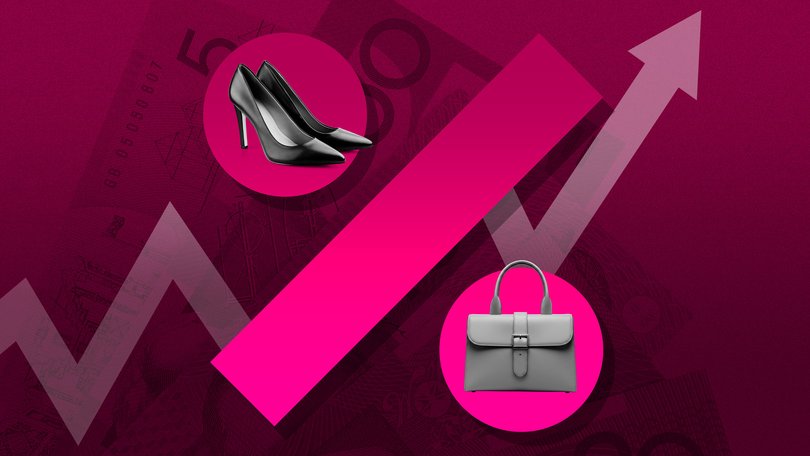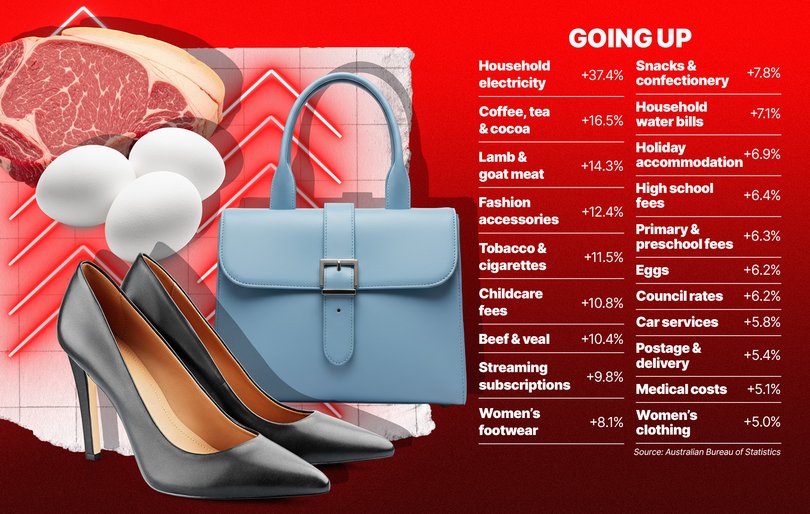Inflation surge hits women harder than men as the price of shoes, clothing and jewellery skyrocket

Australians who watch Netflix, buy takeaway cappuccinos and eat red meat are on the frontline of the inflation resurgence, detailed figures show.
Women are being hit harder than men as prices of shoes, clothing and jewellery rise faster than most other goods.
“If your favourite pastime is to watch Netflix, while eating a snack and drinking coffee, it’s not good for you,” Westpac chief economist Luci Ellis told The Nightly.
Sign up to The Nightly's newsletters.
Get the first look at the digital newspaper, curated daily stories and breaking headlines delivered to your inbox.
By continuing you agree to our Terms and Privacy Policy.The re-emergence of high inflation means the Reserve Bank of Australia is now considered much less likely to cut interest rates. This would leave borrowers with less money for luxuries.
The 37.4 per cent surge in electricity prices in the year ended October 31 was the largest on an Australian Bureau of Statistics list of 91 items published for the first time on Wednesday.
While the quarterly power bills have become an unpleasant experience for many Australians, prices for other products rose four times as fast as the average 3.8 per cent inflation rate, signalling breakouts of inflation across the economy.
Regular treats are now luxury goods
A global shortage of coffee beans led to a 16.5 per cent surge in coffee and cocoa prices for cafes, which often already charge more than $6 for takeaway coffees. Confectionery prices rose 7.8 per cent.
Red meat is becoming a luxury item. Lamb prices soared 14.3 per cent and beef prices rose 10.4 per cent.
Prices for streaming television services rose 9.8 per cent, led by Netflix, which increased its ad-free service by $2 a month to $20.99 in August.
The cost to the average home for digital entertainment rose 24 per cent to $78 a month last financial year, according to Deloitte, reflecting multiple streaming subscriptions.
Younger Generation Z consumers, born since 1997, typically spent $101 a month on streaming services and 98 per cent of them have at least one subscription.
Dr Ellis blamed the climate for making coffee and red meat more expensive. “Coffee, we know there’s a global supply shock on coffee prices. Beef and lamb, we know they went up because that’s just weather,” she said.
Why inflation is sexist
Inflation is a little sexist. The price of women’s footwear increased 8.1 per cent as men’s shoes had the biggest price fall of any category, dropping 2 per cent.
The cost of women’s clothing climbed by 5 per cent compared with just 1.3 per cent for men’s garments including those fancy ties.
AMP economist My Bui said women’s fashion tended to be more cyclical, with prices increasing as stronger consumer sentiment led to more demand for dresses and high heels.
“It does bring me joy when I put on something nice. As a woman, I would say so, yes,” she told The Nightly.
“There’s a bit more discretionary spending in there compared to just essential spending.
“Now that consumer sentiment is getting better, there might be a bit of demand-led inflation in there.”
Fashion accessory prices soared 12.4 per cent, owing to a spike in gold prices.
Jewellery prices are only expected to keep climbing at a steep pace.
“It absolutely does. There’s definitely a lag between the producer price cost of making this jewellery and the actual price that they charge to consumers,” Ms Bui said.
“This inflation that you see in gold price accessories is actually reflecting the previous increases in gold prices in the past year so maybe there’s a bit more to go in that category.”
Parents are also being hit in the hip pocket with childcare fees up by 10.8 per cent. But at least the prices of children’s shoes fell 1.3 per cent. Children’s clothing was a slightly different matter, rising by 3.9 per cent.

Filling your basket on a budget
Healthy eaters were rewarded. Fruit and vegetable prices increased by just 1.3 per cent.
Not all meat eaters were punished either. Fish prices fell by 0.07 per cent. White meat was also cheaper with chicken prices dipping by 1.1 per cent. Pork went up by just 1.4 per cent.
Breakfast cereal costs went up by just 2.7 per cent as milk went up by 3.2 per cent, proving it’s still more economical to eat at home before going to work.
Going out for an ale wasn’t as punishing, with beer costs up by 3 per cent as spirit costs rose by 2.5 per cent, or within the middle of the RBA’s inflation target band.
Takeaway and restaurant meals edged up by 3.3 per cent.
Looking good was also reasonable with haircut costs up 2.7 per cent. Personal care products covering shampoos and moisturisers were 2.1 per cent more expensive.
Domestic holiday accommodation costs soared by 7 per cent with the weak Australian dollar at 65 US cents making overseas trips an expensive exercise. Holiday prices are notoriously volatile.
The e61 Institute’s head of research Gianni La Cava said many Australians would simply holiday closer to home this summer rather than competing for accommodation on the Gold Coast.
For Sydneysiders, that could mean the South Coast, which is an hour’s drive away.
“Probably holiday a bit more close to home than go interstate. That’s what I would do,” he said.
“I’m down in the Shire. I’d probably go a bit further down south to somewhere like Kiama rather than going to Gold Coast, Sunshine Coast.”

